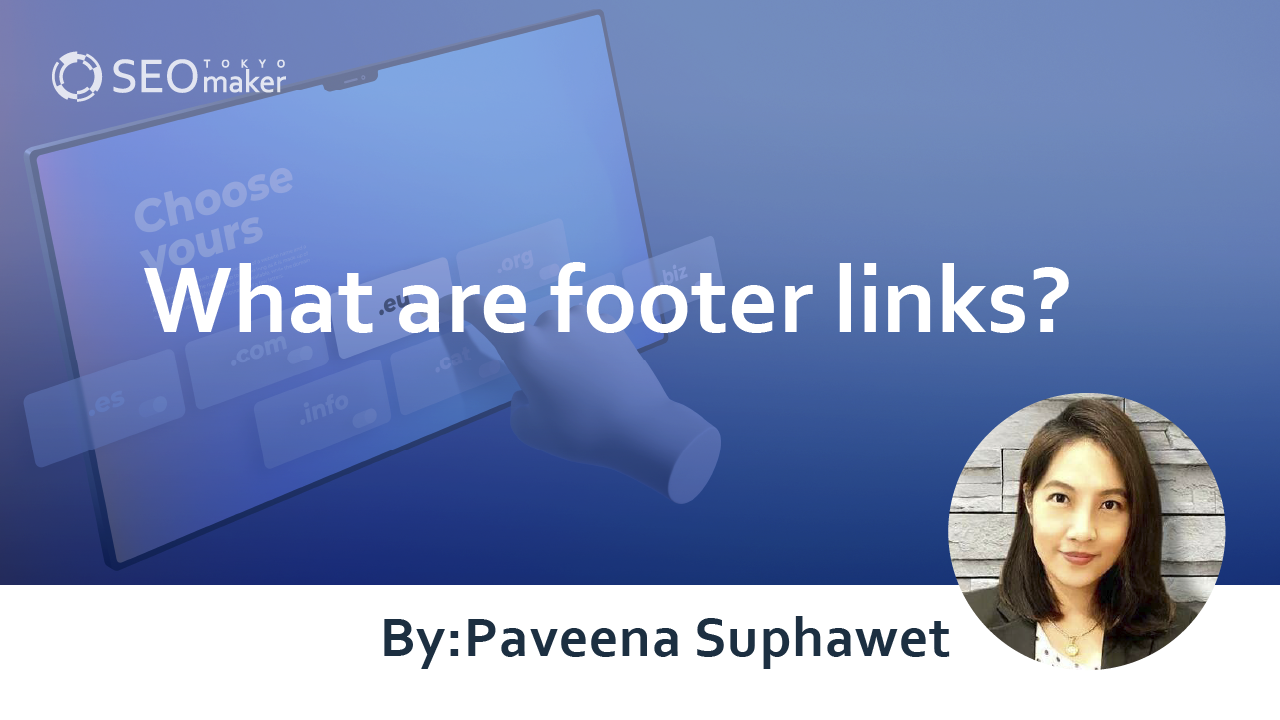What is Footer Links? : The Impact of Footer Links on SEO
contents

Running a website entails essential SEO strategies. With improved SEO, your site’s search rankings rise, attracting more users. Among these strategies, understanding how footer links contribute to SEO is crucial.
Footer links don’t directly affect SEO, but they indirectly enhance user experience by increasing navigation ease and prolonging dwell time, leading to potential positive effects.
In this article, an SEO expert explores the influence of footer links on SEO, discussing whether they have direct effects and what types of links to incorporate, serving as a reference for website creation and management.
At the bottom of web pages lies the footer section, complementing the header at the top. Footer links, situated within this area, comprise menus for navigation purposes.
Footer links serve various functions, such as guiding users back to the content after scrolling or enabling one-click return to the site header without scrolling.
These links are indispensable for efficiently navigating users through the site, significantly impacting the website’s usability assessment.
By facilitating users’ efficient navigation and encouraging longer site stays, footer links indirectly contribute to boosting SEO evaluations. Therefore, footer links become a critical aspect for enhancing SEO evaluations.
Footer links themselves don’t directly influence SEO rankings. Consequently, the content or links embedded in footer links don’t directly affect search rankings.
However, the content placed within footers can indirectly influence SEO positively or negatively. For instance;
- Guiding users to content improves usability
- Placing crawlable content enhances crawler accessibility
- Excessive footer links may have negative effects
Guiding content to enhance usability
When users finish reading content, they often leave the page. However, if they encounter additional content or answers to their queries within the footer, they are more likely to click. This increased click-through rate indicates improved usability via footer links, potentially leading to increased site navigation, prolonged dwell time, and indirect positive SEO effects.
The Impact of Content Placement on Crawling
In SEO, three aspects reign supreme: crawling, indexing, and ranking. Essentially, search engine crawling, or exploration, forms the initial hurdle.
Search engines discover new pages through links. While they can find new pages without links, it’s time-consuming. Therefore, from an SEO standpoint, linking to new pages is crucial.
Utilizing footer links effectively can enhance search engine awareness and potentially expedite indexing, thus contributing to SEO effectiveness.
The quantity of footer links, whether too many or too few, doesn’t directly affect SEO. However, excessively numerous footer links are not recommended.
While Google hasn’t explicitly outlined criteria for penalties, instances suggest that an excessive number of footer links might lead to decreased search rankings or penalties.
However, the mere abundance of footer links doesn’t establish clear standards. While the exact number of footer links isn’t mentioned, having 100 links is acceptable if they provide valuable information to users.
Nonetheless, an excessive number of links can confuse users. Therefore, consider user-friendliness and install clear, relevant links.
Strategically placing links in the footer according to their roles encourages users to navigate the site, indirectly boosting SEO evaluations.
- Site Navigation
- Balancing Site Design
- Installing Important Links
With links in the footer, users can navigate the site even if they’ve scrolled to the bottom without finding the desired information.
While excessive linking isn’t recommended, footers can accommodate more links than headers without compromising site design. Therefore, they can function as a site map, allowing users to grasp the entire site’s structure.
Ideally, users would access the appropriate content before reaching the footer. However, users often overlook information. Hence, it’s crucial to place enticing links in the footer, ensuring users’ continued engagement even after scrolling to the bottom.
Balancing Website Design
The footer plays a crucial role in maintaining the overall balance of a website. Just as with the website’s theme and visuals, the footer’s design needs to align.
Since footers can vary in design, illustrations that suit a cool-themed site may not fit well with a pop theme. To avoid such mismatches, it’s essential to align the footer’s design as much as possible with the overall theme.
Users pay close attention to a website’s theme. Even a slight sense of discord can make it challenging to gain fans of the website. Therefore, the footer, which serves as the conclusion of the website, is a vital point for upholding the theme and refining the design.
Placing Important Links
Among users who access a website, some may have found the information they sought while scrolling. However, even after scrolling to the bottom of the page, some users return to click on content or contact links.
Since such users are not uncommon, it’s beneficial to place important links in the footer. This allows users to access them without scrolling back up, saving them the trouble of returning. Moreover, it helps prevent users from missing information they recognized while scrolling back up.
By including category pages, content that users are most interested in, and essential links in the footer, you can prevent users from leaving. Redirecting them to inquiry or reservation forms can further prevent user departure.
Although footer links don’t have a direct impact on SEO, the links you include significantly influence whether users stay and navigate through the site.
Therefore, it’s essential to include links to high-priority content and content that users are likely to seek next.
Additionally, it’s common to include the following information.
- Privacy Policy
- Information based on Specific Commercial Transactions
- Site Map
- Inquiry Form
- Company Information
- Social Media Information
Privacy Policy
A privacy policy outlines the policies regarding the protection of personal information. While it’s not always necessary to disclose a privacy policy, it’s essential for maintaining a clean image when providing company services.
Since the privacy policy page should be easily accessible to everyone, it’s advisable to place a link to it in the header or footer of the first page visitors see when accessing the website.
Notices Based on the Act on Specified Commercial Transactions
The Act on Specified Commercial Transactions is a law aimed at protecting consumers. When selling products or content on a website, it’s necessary to provide notices based on the Act on Specified Commercial Transactions. Similar to a privacy policy, easily accessible links are required for maintaining a clean image of sales.
Since notices based on the Act on Specified Commercial Transactions contain important information, placing them in the header or footer can enhance user confidence and trust. Since there’s limited space for links in the header, it’s generally recommended to place them in the footer.
Site Map
There are two types of sitemaps: XML sitemaps for search engines and HTML sitemaps for users. By placing an HTML sitemap for users in the footer links, usability can be improved.
An HTML sitemap is a page that consolidates all pages of a website into one. You can create a pathway from the footer links to the sitemap, or in the case of a small-scale site, the footer link itself can lead to the sitemap.
Depending on the amount of content, the necessity and type of sitemap may vary. If the content categories of your website are expected to continue growing, it’s advisable to create a separate page for the sitemap instead of initially placing it in the footer.
For websites with more content, it’s crucial to consider implementing a sitemap, as having a lot of content can lead to users missing things on the first view or in the header, making it necessary to re-engage them for further exploration.
Contact Form
While every website has a purpose, often conversions come in the form of purchases or inquiries. Placing conversion buttons prominently on the site’s top is crucial, but including contact information at the end of articles or in footer links can also be highly effective.
While having a button leading to the contact page is good, embedding the contact form itself can enhance usability by allowing conversions without transitioning.
Company Information
Even if users like the content or products, they may still be interested in knowing more about the company behind it. While company information is typically found in the header, placing it in the footer can still attract user attention and access.
SNS Information
Adding links to social media networks (SNS) in the footer can also be effective. By linking to SNS profiles, you can provide additional information to users who are already interested in your website.
Users who scroll down to the footer are likely to have a high interest in the website’s content or brand. Linking to SNS platforms, which offer a more intimate connection, can deepen their engagement and potentially turn them into loyal fans, making footer links a valuable addition.
While footer links can be useful depending on how they’re used, there are two important considerations.
- Low Click-Through Rate
- Not the First Link
Low Click-Through Rate
While it’s effective to include links in the footer that encourage users to take further actions, users often leave a page after finishing reading an article without clicking any additional links unless they are particularly interested in specific content.
Footer links can assist in navigation, but it’s important to recognize that they generally have a low click-through rate.
If the goal is to encourage navigation, it’s better to create pathways to other content within the main content or immediately after it rather than relying solely on footer links.
Not the First Link
There can be any number of links on a page, including multiple links to the same page. However, for SEO purposes, only the first link to the same page is evaluated. If a footer link is the second or subsequent link to the same page, it won’t contribute positively to SEO evaluation. While it may enhance usability, from an SEO perspective, it could be considered redundant.
Summary
Footer links don’t directly impact SEO, but depending on the links you include, they can indirectly improve user engagement and site metrics, which in turn can benefit SEO. Footer links play a crucial role in site navigation and should be used to maintain a well-designed website and provide essential information or links necessary for website operation.
The links you choose to include in the footer should be based on the specific needs of your website, so consider your website’s situation when deciding which links to include.






![Is SEO Difficult and Prone to Failure? [Insights from Experience]](https://www.switchitmaker2.com/en/wp-content/uploads/2024/05/seo-insights-150x150.webp)



![What is a Description? Explaining the Meaning, Writing Style, and Changing Word Count – [2023 Edition]](https://www.switchitmaker2.com/en/wp-content/uploads/2024/09/what-is-description.webp)










